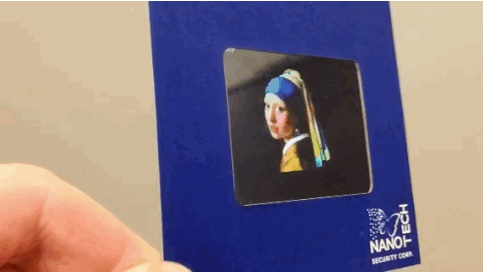Nanotech Security, a Vancouver-area business focused on anti-counterfeiting strategies which has been featured here a number of times, has secured two patents according to a May 30, 2015 news item on Nanotechnology Now,
Nanotech Security Corp. (TSXV: NTS) (OTCQX: NTSFF), announced that the Company has been granted two patents; one from the United States Patent and Trademark Office and one from the European Patent Office. The Company continues to expand the protection of its technology with the addition of these patents to its intellectual property portfolio.
Clint Landrock, Nanotech Chief Technology officer, commented, “We are pleased to be granted these additional patents as they further solidify our hold on the next generation of authentication technologies for the banknote, branding and secure document industries.”
Notech Security’s May 27, 2015 news release, which originated the news item, provides more details about the technology being patented,
Based on these patents the Company has launched “Pearl”, our first foray in plasmonic full colour images. A nano array image of Vermeer’s famous painting “Girl with a Pearl Earring”, which brilliantly displays her ruby lips, blue scarf and bright white collar and features two distinct authentication viewing modes in one feature. The user can view the full colour image in both transmission and reflection (shining a light on or through the image) – an effect impossible for a hologram to achieve. …
Here’s Pearl,
The news release goes on,
Doug Blakeway, Nanotech Chief Executive Officer, commented, “An initial showing of Pearl to the banknote industry came back with comments of having never seen such a bright visual effect in a security device.” Immediate interest in Pearl has initiated discussions with issuing authorities.
EPO No. 2,563,602 names Charles MacPherson as the inventor. The patent covers layered optically variable devices (“OVDs”) such as colour shift foils that uniquely employs additional interactivity using piezoelectric layers to activate the authentication mode of a security device used as threads in products such as banknotes, passports and secure packaging. This patented multi-layered thin film technology offers Nanotech a competitive edge in the development of colour shifting security devices.
USPTO No. 9,013,272 names Dr. Bozena Kaminska and Clint Landrock as co-inventors. Building on patents previously granted to Nanotech, this patent secures integral intellectual property, which covers a range of diffractive and plasmonic luminescent devices such as security features used in banknotes.
…
Nano facility in Alberta
Presumably this Canadian federal government announcement about funding for a nanotechnology facility at the Northern Alberta Institute of Technology (NAIT) is in anticipation of a Fall 2015 election (from a May 31, 2015 news item on Nanotechnology Now,
Today [Friday, May 29, 2015], the Honourable Michelle Rempel, Minister of State for Western Economic Diversification, announced $1.5 million in funding to support the Northern Alberta Institute of Technology (NAIT) in establishing a centre that will allow small- and medium-sized enterprises (SMEs) to test, develop, and commercialize micro- and nano-coated products.
A May 29, 2015 Western Economic Diversification Canada news release on MarketWired expands on the theme,
Federal funding will enable NAIT to purchase specialized coating handling and blasting equipment, a spray booth, cutting machines, compressors, and to upgrade the facility’s ventilation system and power supply.
The facility, which is also receiving support from MesoCoat Technology Canada, will operate within the existing Nanotechnology Centre for Applied Research, Industry Training and Services (nanoCARTS), and is expected to benefit a wide range of sectors including oil and gas, surface technology and engineering.
Quick Facts
- Since 2006, the federal government has invested more than $13 billion in new funding in all facets of the innovation ecosystem including advanced research, research infrastructure, talent development, and business innovation.
- NAIT’s nanoCARTS provides industry with prototyping, product enhancement, testing and characterization services related to nano and micro technology. The new facility will help to expand nanoCARTS’ range of services available to SMEs.
- NAIT has the expertise in rapid prototyping, materials testing, manufacturing, training and mechanical design to help companies develop and commercialize new products.
Quotes
“Our Government understands that technology advancements help increase Western Canada’s competitive advantage. By investing in the establishment of this new micro- and nano-coated product development centre, we are demonstrating our commitment to supporting jobs and economic growth.”
- The Honourable Michelle Rempel, Minister of State for Western Economic Diversification
“Applied research is essential in NAIT’s role as a leading polytechnic. This investment strengthens our ability to work with industry to solve their real-world problems. This ultimately helps them to be competitive and innovative. I would like to thank the Government of Canada for its investment.”
- Dr. Glenn Feltham, President and CEO, NAIT
“We are grateful to the Government of Canada for their financial and strategic support, which has been instrumental in establishing this centre at NAIT. The applied research we are carrying out has the potential to extend the lifespan of piping used in oil production and save billions of dollars in downtime and replacement costs. Wear-resistant clad pipes being developed at this centre are expected to make oil production safer, more efficient and more affordable.”
- Stephen Goss, CEO, MesoCoat Technology Canada
That would seem to be the sum total of the Canadian commercialization effort at the moment. It contrasts somewhat with the US White House and its recently announced new initiatives to commercialize nanotechnology (see my May 27, 2015 post for a list).
